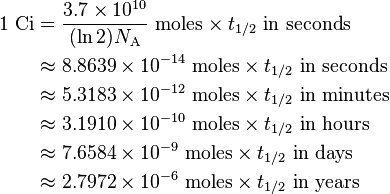Curie
The curie (symbol Ci) is a non-SI unit of radioactivity, named after Marie and Pierre Curie.[1][2] It is defined as
While its continued use is discouraged by NIST[3] and other bodies, the curie is widely used throughout the US government and industry.
One curie is roughly the activity of 1 gram of the radium isotope 226Ra, a substance studied by the Curies.
The SI derived unit of radioactivity is the becquerel (Bq), which equates to one decay per second. Therefore:
- 1 Ci = 3.7 × 1010 Bq = 37 GBq = 37,000,000,000 atoms decaying per second
and
- 1 Bq ≅ 2.703 × 10−11 Ci ≅ 27 pCi
Another commonly used measure of radioactivity is the microcurie:
- 1 μCi = 3.7 × 104 disintegrations per second = 2.22 × 106 disintegrations per minute
Correspondingly, and more commonly encountered with natural levels of radiation, a picocurie is:
- 1 pCi = 0.037 disintegrations per second = 2.22 disintegrations per minute
The power in milliwatts emitted by one curie of radiation can be calculated by taking the number of MeV for the radiation times approximately 5.93.
A radiotherapy machine may have roughly 1000 Ci of a radioisotope such as caesium-137 or cobalt-60. This quantity of radioactivity can produce serious health effects with only a few minutes of close-range, unshielded exposure.
Ingesting even a millicurie is usually fatal (unless it is a very short-lived isotope). For example, the LD-50 for ingested polonium-210 is 240 μCi, about 5.5 nanograms.
The typical human body contains roughly 0.1 μCi (14 mg) of naturally occurring potassium-40. A human body containing 16 kg of carbon (see Composition of the human body) would also have about 24 nanograms or 0.1 μCi of carbon-14. Together, these would have an activity of approximately 2×0.1 μCi or 7400 decays (mostly from beta decay and rarely from gamma decay) per second inside the person's body.
Curies as a measure of quantity
Curies are occasionally used to express a quantity of radioactive material rather than a decay rate, such as when one refers to 1 Ci of caesium-137. This may be interpreted as the number of atoms that would produce 1 Ci of radiation. The rules of radioactive decay may be used to convert this to an actual number of atoms. They state that 1 Ci of radioactive atoms would follow the expression:
- N (atoms) × λ (s−1) = 1 Ci = 3.7 × 1010 (Bq)
and so,
- N = 3.7 × 1010 / λ,
where λ is the decay constant in (s−1).
We can also express a Curie in moles:
where NA is Avogadro's number and t1/2 is the half life. The number of moles may be converted to grams by multiplying by the atomic mass.
Here are some examples:
| Isotope | Half life | Mass of 1 Curie | Specific activity (Ci/g) |
|---|---|---|---|
| 232Th | 1.405×1010 years | 9.1 tonnes | 1.1×10−7 (110,000 pCi/g, 0.11 µCi/g) |
| 238U | 4.471×109 years | 2.977 tonnes | 3.4×10−7 (340,000 pCi/g, 0.34 µCi/g) |
| 40K | 1.25×109 years | 140 kg | 7.1×10−6 (7,100,000 pCi/g, 7.1 µCi/g) |
| 235U | 7.038×108 years | 463 kg | 2.2×10−6 (2,160,000 pCi/g, 2.2 µCi/g) |
| 129I | 15.7×106 years | 5.66 kg | 0.00018 |
| 99Tc | 211×103 years | 58 g | 0.017 |
| 239Pu | 24.11×103 years | 16 g | 0.063 |
| 240Pu | 6563 years | 4.4 g | 0.23 |
| 226Ra | 1601 years | 1.01 g | 0.99 |
| 241Am | 432.6 years | 0.29 g | 3.43 |
| 14C | 5730 years | 0.22 g | 4.5 |
| 238Pu | 88 years | 59 mg | 17 |
| 137Cs | 30.17 years | 12 mg | 83 |
| 90Sr | 28.8 years | 7.2 mg | 139 |
| 241Pu | 14 years | 9.4 mg | 106 |
| 60Co | 1925 days | 883 μg | 1132 |
| 210Po | 138 days | 223 μg | 4484 |
| 3H | 12.32 years | 104 μg | 9621 |
| 131I | 8.02 days | 8 μg | 125000 |
| 123I | 13 hours | 0.5 μg | 2000000 |
The number of Curies present in a sample decreases with time because of decay.
Radiation Related Quantities
The following table shows radiation quantities in SI and non-SI units.
| Quantity | Name | Symbol | Unit | Year |
|---|---|---|---|---|
| Exposure (X) | roentgen | R | esu / 0.001293 g of air | 1928 |
| Absorbed dose (D) | erg•g−1 | 1950 | ||
| rad | rad | 100 erg•g−1 | 1953 | |
| gray | Gy | J•kg−1 | 1974 | |
| Activity (A) | curie | Ci | 3.7 × 1010 s−1 | 1953 |
| becquerel | Bq | s−1 | 1974 | |
| Dose equivalent (H) | roentgen equivalent man | rem | 100 erg•g−1 | 1971 |
| sievert | Sv | J•kg−1 | 1977 | |
| Fluence (Φ) | (reciprocal area) | cm−2 or m−2 | 1962 |
See also
- Geiger counter
- Ionizing radiation
- Radiation exposure
- Radiation poisoning
- Radiation burn
- United Nations Scientific Committee on the Effects of Atomic Radiation
References
- ↑ curie - Britannica Online Encyclopedia
- ↑ Paul W. Frame. "How the Curie Came to Be". Retrieved 2008-04-30.
- ↑ Nist Special Publication 811, paragraph 5.2.
